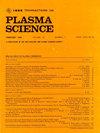Time Evolution of Plasma Impedance Estimated From Plasma Potential and Current in Atmospheric Pressure Plasma Jet
IF 1.3
4区 物理与天体物理
Q3 PHYSICS, FLUIDS & PLASMAS
引用次数: 0
Abstract
The potential and current of the plasma bullet are estimated from the difference in applied voltage and power-line current with and without plasma on time evolution in the atmospheric pressure plasma jet. The plasma impedance is derived by dividing the plasma potential by the plasma current. Because the time variations of the plasma potential and current differ, it is difficult to derive the time-varying phase difference. The plasma inductance is derived from the plasma potential and the time derivative of the plasma current. The plasma capacitance is derived from the plasma potential and the time integral of the plasma current, which represents plasma charge. The plasma impedance represents a capacitive load in the first half of plasma generation over time and an inductive load in the second half with the plasma bullet traveling. Consequently, when the plasma impedance is at its minimum, the reactance component is canceled out and the plasma impedance is equal to the resistance of the plasma.大气压等离子体射流中等离子体电位和电流估计等离子体阻抗的时间演化
根据大气压等离子体射流中有和无等离子体时外加电压和电力线电流随时间变化的差值,估计了等离子体弹的电势和电流。等离子体阻抗由等离子体电位除以等离子体电流得到。由于等离子体电位和电流的时变不同,因此很难推导出时变相位差。等离子体电感由等离子体电位和等离子体电流的时间导数推导而来。等离子体电容由等离子体电位和等离子体电流的时间积分得到,等离子体电流表示等离子体电荷。等离子体阻抗表示等离子体随时间产生的前半段的容性负载和等离子体子弹行进的后半段的感性负载。因此,当等离子体阻抗最小时,电抗分量被抵消,等离子体阻抗等于等离子体的电阻。
本文章由计算机程序翻译,如有差异,请以英文原文为准。
求助全文
约1分钟内获得全文
求助全文
来源期刊

IEEE Transactions on Plasma Science
物理-物理:流体与等离子体
CiteScore
3.00
自引率
20.00%
发文量
538
审稿时长
3.8 months
期刊介绍:
The scope covers all aspects of the theory and application of plasma science. It includes the following areas: magnetohydrodynamics; thermionics and plasma diodes; basic plasma phenomena; gaseous electronics; microwave/plasma interaction; electron, ion, and plasma sources; space plasmas; intense electron and ion beams; laser-plasma interactions; plasma diagnostics; plasma chemistry and processing; solid-state plasmas; plasma heating; plasma for controlled fusion research; high energy density plasmas; industrial/commercial applications of plasma physics; plasma waves and instabilities; and high power microwave and submillimeter wave generation.
 求助内容:
求助内容: 应助结果提醒方式:
应助结果提醒方式:


